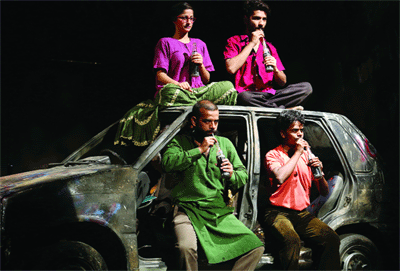Directed by Neelam Mansingh Chowdhry, Bitter Fruit is an adaptation of Manto’s short stories. She tells Utpal K Banerjee that the play explores the underbelly of revenge and rejection
If there could be one single author who exorcised the demons of the Indo-Pakistan Partition that traumatised the entire land in 1947, it was Sadat Hasan Manto (1912-1955). In portraying the darkness of the human psyche, as humanitarian values progressively declined, his works grew from the prevailing social climate and reflected an innate sense of desperate impotency towards darkness and revealed a satire that verged on dark comedy.
His oeuvre not only showed the influence of his own demons but also that of the collective madness that he saw in the last decade of his life. To add to it, his numerous court-cases and societal rebukes deepened his cynical view of society, from which he felt utterly isolated. No part of human existence remained untouched or taboo for him and he candidly outpoured stories of prostitutes and pimps alike, just as he highlighted the subversive sexual slavery of the women of his times.
To many contemporary women writers, his language portrays reality and provides them with the dignity they justly deserve. He is known today for a scathing insight into human behaviour as well as revelation of the macabre animalistic nature of an enraged people of his time.
Bitter Fruit, presented recently by the final year NSD students, was an adaptation of Manto’s short stories. Directed by the Chandigarh-based thespian Neelam Mansingh Chowdhry, it is an amalgam of many characters, who pop in and out of Manto’s narrative and speak a lingo that is almost his, but not entirely. In the mise en scene, what attracts the audience attention most is the ramshackle remains of a discarded sedan car: used for playing hide-and-seek by kids or as an alcove for the cooing couple or as a retreat for the writer, jotting down his detached observations of the surroundings.
The next is the swing-rope: used in adolescent games or the inevitable honey trap for the romantically-minded. There is also the balcony somewhere above as another recess for the author. Or there is the balustrade — framed high up — housing the seated semi-attired prostitute, who raucously initiates the debutantes into the art of love-making.
Indeed, Manto’s milieu is always studded with a bevy of prostitutes: centre-stage or marginalised; indifferent or doling out favours; even live or dead, allowing necrophilia to have copulation with a putrefied maiden. Male characters — both vividly seen or lurking out of Manto’s stories — occasionally look like stock ones, and are generally shoddy and distracted; scantily clad and putting up, on the whole, a miserable picture.
There is also the celebrated brand of Neelam Mansingh’s own pre-occupation with the primordial elements of earth, fire, water and air. Sans fire, the other three are present here aplenty: kneading, pasting or plastering muddy earth; bathing with, sprinkling or ducking frothy soap-bubbles; spraying powders or flying the kite. The mummified, bandaged busts out of living bodies — physically created before the spectators’ eyes at the end — verge almost on gimmicky.
“We had no script to begin with; a collection of Manto’s fiction was our starting point. I wanted the actors to make the stories their own, to relate to what the loss and destruction, ruptures and migration meant to them. How that could be fed into a narrative — in a manner that was both real and rational — was the challenge all of us set for ourselves,” informs the director.
On how were the stories chosen, she says, “The stories were chosen by the students. The flow-structure may appear non-linear and haphazard, which could be viewed as episodic or as a vignette of the world the characters inhabit. But I saw an intangible thread that links the stories to each other.”
To Chowdhry, the process has always been more meaningful than the ultimate finish. She says, “We have collectively tried to explore the underbelly of revenge and rejection, madness and brutality, the lives of those who live on the margins, the forgotten people — much akin to the Toulouse lautrec paintings in the West. I’ve tried to bring to the production a ‘lightness’ that provides a foil to the harsh times that we live in.”
The play’s title refers to the Partition and its aftermath. The director also wanted to ensure that a meditative layer was kept alive; hence the improvisation in the stories. Everyday gestures are engaged in a conversation with one’s collective memory; stories and histories are re-arranged and made fluid.
Sharing Manto’s overall concept, the director says, “Someone asked: ‘How else can we imagine living together, without the ability to see beyond where we are; to find ourselves linked with others we have never directly known; to understand that — in some abiding and urgent sense — we share a worldIJ’ These words have a resonance in the writings of Manto. The world Manto creates may be far removed but feels intimate with their tales of search, seduction and loss.”


























